Morphological Discrepancy of Various Basic Oxygen Furnace Steel Slags and Road Performance of Corresponding Asphalt Mixtures
Abstract
:1. Introduction
2. Materials and Methods
2.1. Raw Materials
2.2. Asphalt Mixture Design
2.3. Experimental Methods
2.3.1. Characterization
2.3.2. Morphological Discrepancy
2.3.3. Road Performance
3. Results and Discussions
3.1. Characterization
3.2. Morphological Discrepancy
3.3. Road Performance
3.3.1. High Temperature Stability
3.3.2. Moisture Resistance Ability
3.3.3. Low Temperature Cracking Resistance Ability
3.4. Mechanism between Steel Slag Performance and Road Performance
4. Conclusions
Author Contributions
Funding
Acknowledgments
Conflicts of Interest
References
- Cui, P.Q.; Wu, S.P.; Xiao, Y.; Wan, M.; Cui, P.D. Inhibiting effect of layered double hydroxides on the emissions of volatile organic compounds from bituminous materials. J. Clean. Prod. 2015, 108, 987–991. [Google Scholar] [CrossRef]
- Skaf, M.; Manso, J.M.; Aragón, Á.; Fuente-Alonso, J.A.; Ortega-López, V. EAF slag in asphalt mixes: A brief review of its possible re-use. Resour. Conserv. Recycl. 2017, 120, 176–185. [Google Scholar] [CrossRef]
- Chen, Z.W.; Wu, S.P.; Wen, J.; Zhao, M.L.; Yi, M.W.; Wan, J.M. Utilization of gneiss coarse aggregate and steel slag fine aggregate in asphalt mixture. Constr. Build. Mater. 2015, 93, 911–918. [Google Scholar] [CrossRef]
- Shu, B.A.; Zhang, L.; Wu, S.P.; Dong, L.J.; Liu, Q.T.; Wang, Q. Synthesis and characterization of compartmented Ca-alginate/silica self-healing fibers containing bituminous rejuvenator. Constr. Build. Mater. 2018, 190, 623–631. [Google Scholar] [CrossRef]
- Zongwu, C.; Yuyong, J.; Shaopeng, W.; Fubin, T. Moisture-induced damage resistance of asphalt mixture entirely composed of gneiss and steel slag. Constr. Build. Mater. 2018, 177, 332–341. [Google Scholar]
- Yi, H.; Xu, G.; Cheng, H.; Wang, J.; Wan, Y.; Chen, H. An overview of utilization of steel slag. Procedia Environ. Sci. 2012, 16, 791–801. [Google Scholar] [CrossRef]
- Chao, L.; Chen, Z.; Wu, S.; Bo, L.; Xie, J.; Yue, X. Effects of steel slag fillers on the rheological properties of asphalt mastic. Constr. Build. Mater. 2017, 145, 383–391. [Google Scholar]
- Li, C.; Wu, S.L.; Chen, Z.; Tao, G.; Xiao, Y. Enhanced heat release and self-healing properties of steel slag filler based asphalt materials under microwave irradiation. Constr. Build. Mater. 2018, 193, 32–41. [Google Scholar] [CrossRef]
- Kambole, C.; Paige-Green, P.; Kupolati, W.K.; Ndambuki, J.M.; Adeboje, A.O. Basic oxygen furnace slag for road pavements: A review of material characteristics and performance for effective utilisation in southern Africa. Constr. Build. Mater. 2017, 148, 618–631. [Google Scholar] [CrossRef]
- Xie, J.; Wu, S.; Lin, J.; Cai, J.; Chen, Z.; Wei, W. Recycling of basic oxygen furnace slag in asphalt mixture: Material characterization & moisture damage investigation. Constr. Build. Mater. 2012, 36, 467–474. [Google Scholar]
- Ko, M.S.; Chen, Y.L.; Jiang, J.H. Accelerated carbonation of basic oxygen furnace slag and the effects on its mechanical properties. Constr. Build. Mater. 2015, 98, 286–293. [Google Scholar] [CrossRef]
- López-Díaz, A.; Ochoa-Díaz, R.; Grimaldo-León, G.E. Use of BOF slag and blast furnace dust in asphalt concrete: an alternative for the construction of pavements. Dyna 2018, 85, 24–30. [Google Scholar]
- Qazizadeh, M.J.; Farhad, H.; Kavussi, A.; Sadeghi, A. Evaluating the fatigue behavior of asphalt mixtures containing electric arc furnace and basic oxygen furnace slags using surface free energy estimation. J. Clean. Prod. 2018, 188, 355–361. [Google Scholar] [CrossRef]
- Wu, S.P.; Xue, Y.J.; Ye, Q.S.; Chen, Y.C. Utilization of steel slag as aggregates for stone mastic asphalt (SMA) mixtures. Build. Environ. 2007, 42, 2580–2585. [Google Scholar] [CrossRef]
- Shen, D.H.; Wu, C.M.; Du, J.C. Laboratory investigation of basic oxygen furnace slag for substitution of aggregate in porous asphalt mixture. Constr. Build. Mater. 2009, 23, 453–461. [Google Scholar] [CrossRef]
- Zhang, Z.H.; Liao, J.L.; Ju, J.T.; Dang, Y.J. Treatment process and utilization technology of steel slag in China and Abroad. J. Iron. Steel Res. 2013, 25, 1–4. [Google Scholar] [CrossRef]
- Guo, H. Selection of steel slag processing technology. Energy Metall. Ind. 2011, 25, 14–20. [Google Scholar]
- Juckes, L.M. The volume stability of modern steelmaking slags. Miner. Process. Extr. Metall. Trans. 2003, 112, 177–197. [Google Scholar] [CrossRef]
- Zhou, Z.; Ming, H. Analysis of affecting factors on thermal stability of asphalt mixtures. J. Highw. Transp. Res. Dev. 2004, 6, 15–21. [Google Scholar]
- Xue, Y.J.; Wang, C.; Hu, Z.H.; Zhou, Y.; Liu, G.; Hou, H.B. Thermal treatment on sewage sludge by electromagnetic induction heating: Methodology and drying characterization. Waste Manag. 2018, 78, 917–928. [Google Scholar] [CrossRef]
- Li, C.; Wu, S.; Chen, Z.; Shu, B.; Li, Y.; Xiao, Y.; Liu, Q. Synthesis of Fe3O4-decorated Mg-Al layered double hydroxides magnetic nanosheets to improve anti-ultraviolet aging and microwave absorption properties used in asphalt materials. Constr. Build. Mater. 2019, 220, 320–328. [Google Scholar] [CrossRef]
- Chen, Z.W.; Xie, J.; Xiao, Y.; Chen, J.Y.; Wu, S.P. Characteristics of bonding behavior between basic oxygen furnace slag and asphalt binder. Constr. Build. Mater. 2014, 64, 60–66. [Google Scholar] [CrossRef]
- Ziaee, S.A.; Kavussi, A.; Jalili Qazizadeh, M.; Mohammadzadeh Moghadam, A. Avaluation of long term ageing of asphalt mixtures containing eaf and bof steel slags. Int. J. Transp. Eng. 2015, 5, 65–72. [Google Scholar]
- Ameri, M.; Hesami, S.; Goli, H. Laboratory evaluation of warm mix asphalt mixtures containing electric arc furnace (EAF) steel slag. Constr. Build. Mater. 2013, 49, 611–617. [Google Scholar] [CrossRef]
- Shu, B.; Wu, S.; Dong, L.; Li, C.; Kong, D.; Yang, X. Synthesis and properties of microwave and crack responsive fibers encapsulating rejuvenator for bitumen self-healing. Mater. Res. Express 2019, 6, 30–35. [Google Scholar] [CrossRef]
- Shu, B.; Wu, S.; Dong, L.; Norambuena-Contreras, J.; Yang, X.; Li, C. Microfluidic synthesis of polymeric fibers containing rejuvenating agent for asphalt self-healing. Constr. Build. Mater. 2019, 219, 176–183. [Google Scholar] [CrossRef]
- Prowell, B.D.; Zhang, J.; Brown, E.R. Aggregate properties and the performance of superpave-designed Hot Mix Asphalt. Nchrp Report. 2005, 4, 93–101. [Google Scholar]
- Masad, E.A. Aggregate Imaging System (AIMS): Basics and Applications. Blending 2005, 23, 453–461. [Google Scholar]
- Ma, T.; Wang, H.; He, L.; Zhao, Y.L.; Huang, X.M.; Chen, J. Property characterization of asphalt binders and mixtures modified by different crumb rubbers. J. Mater. Civ. Eng. 2017, 29, 50–55. [Google Scholar] [CrossRef]
- Ma, T.; Zhang, D.Y.; Zhang, Y.; Wang, S.Q.; Huang, X.M. Simulation of wheel tracking test for asphalt mixture using discrete element modelling. Road Mater. Pavement Des. 2018, 19, 367–384. [Google Scholar] [CrossRef]
- Pan, P.; Wu, S.P.; Xiao, Y.; Liu, G. A review on hydronic asphalt pavement for energy harvesting and snow melting. Renew. Sustain. Energy Rev. 2015, 48, 624–634. [Google Scholar] [CrossRef]
- Mason, B. The constitution of some basic open-hearth slags. J. Iron Steel Inst. 1994, 12, 69–80. [Google Scholar]
- Wang, Q.; Yan, P.; Han, S. The influence of steel slag on the hydration of cement during the hydration process of complex binder. Sci. China Technol. Sci. 2011, 54, 388–394. [Google Scholar] [CrossRef]
- Masad, E.; Olcott, D.; White, T.; Tashman, L. Correlation of fine aggregate imaging shape indices with asphalt mixture performance. Transp. Res. Rec. 2001, 1757, 148–156. [Google Scholar] [CrossRef]
- Mallat, S.G. A theory for multiresolution signal decomposition: the wavelet representation. IEEE Trans. Pattern Anal. Mach. Intell. 1989, 158, 231–242. [Google Scholar] [CrossRef]
- Chen, Z.W.; Wu, S.P.; Xiao, Y.; Zeng, W.B.; Yi, M.W.; Wan, J.M. Effect of hydration and silicone resin on Basic Oxygen Furnace slag and its asphalt mixture. J. Clean. Prod. 2016, 112, 392–400. [Google Scholar] [CrossRef]

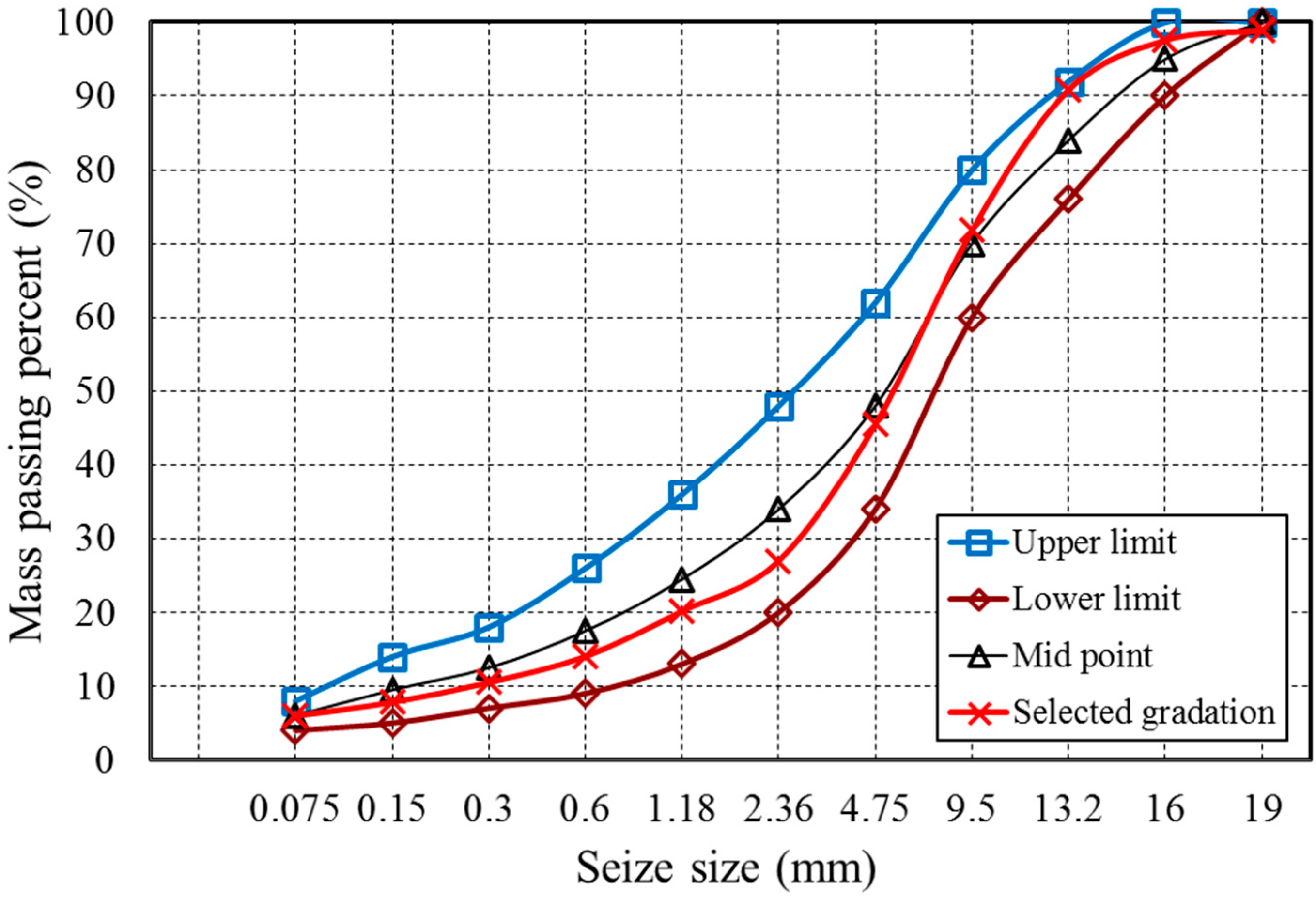



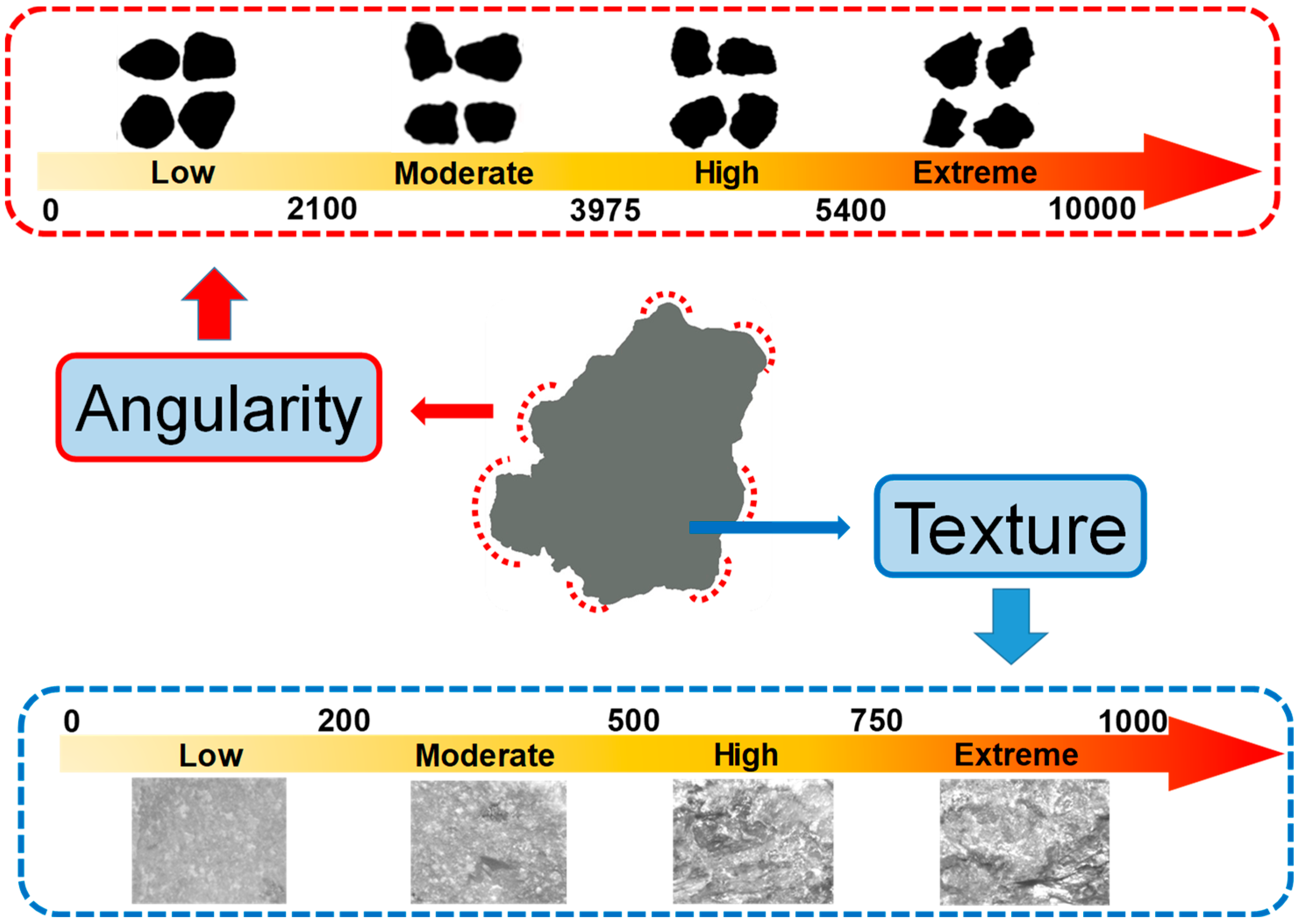
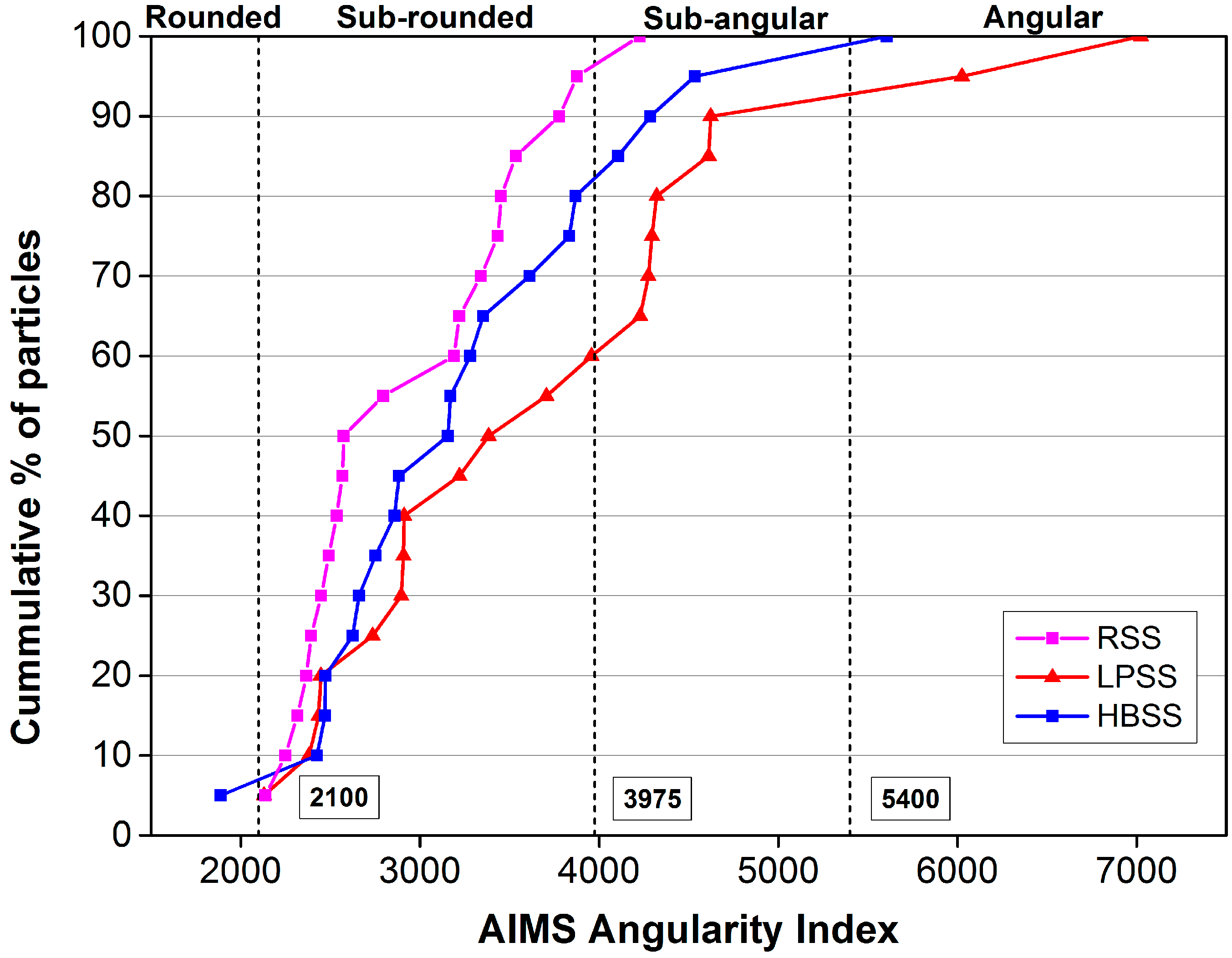

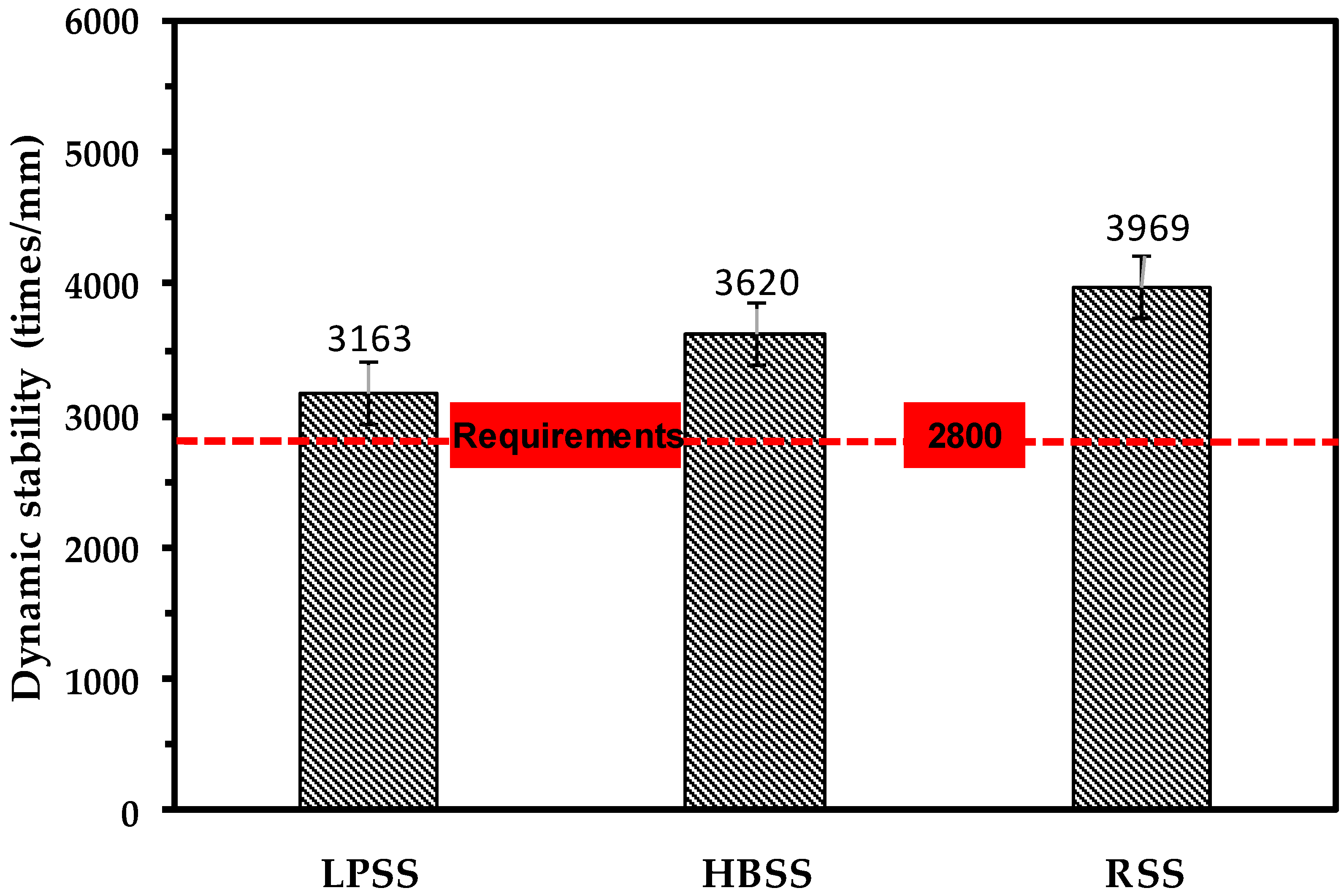

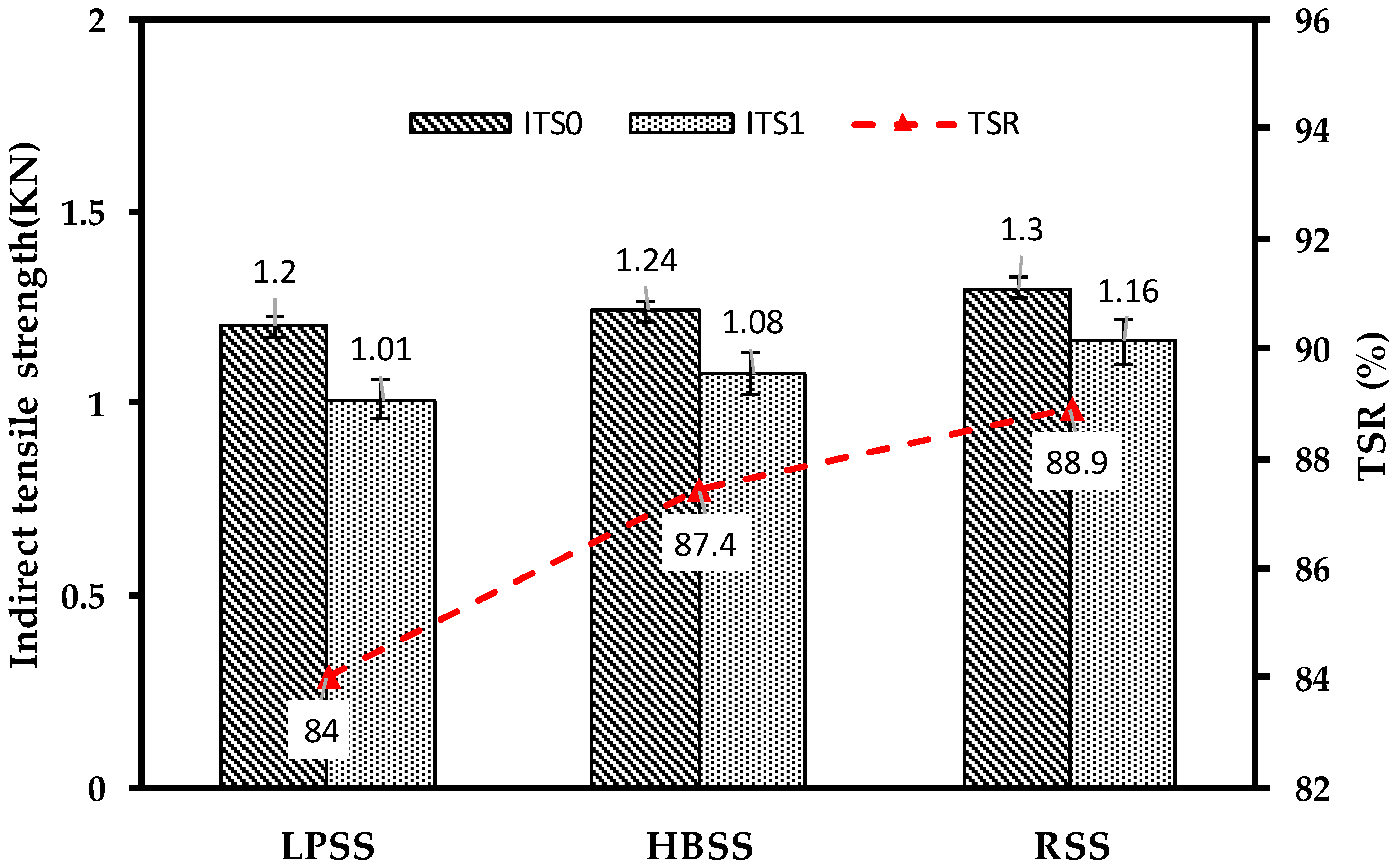
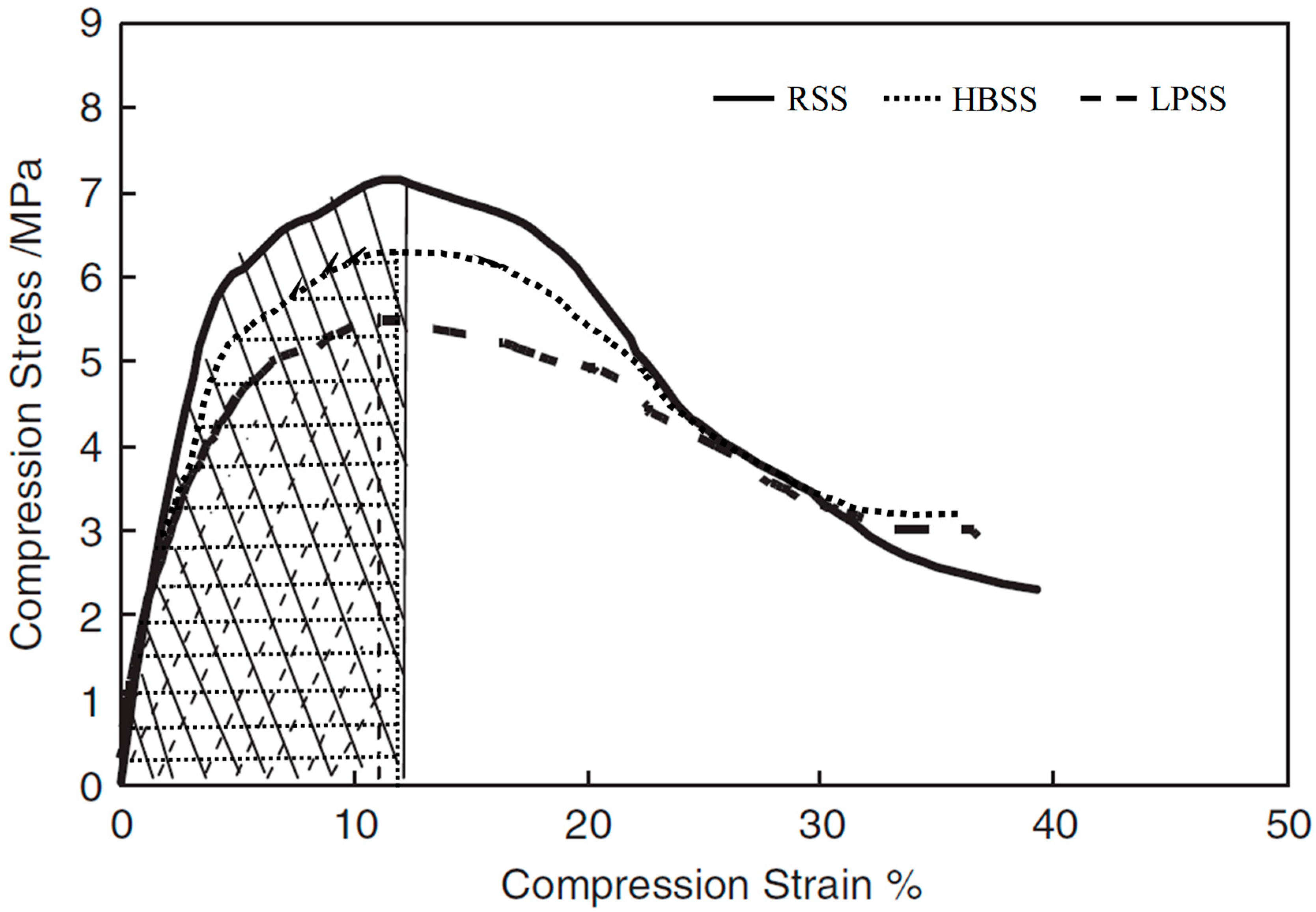

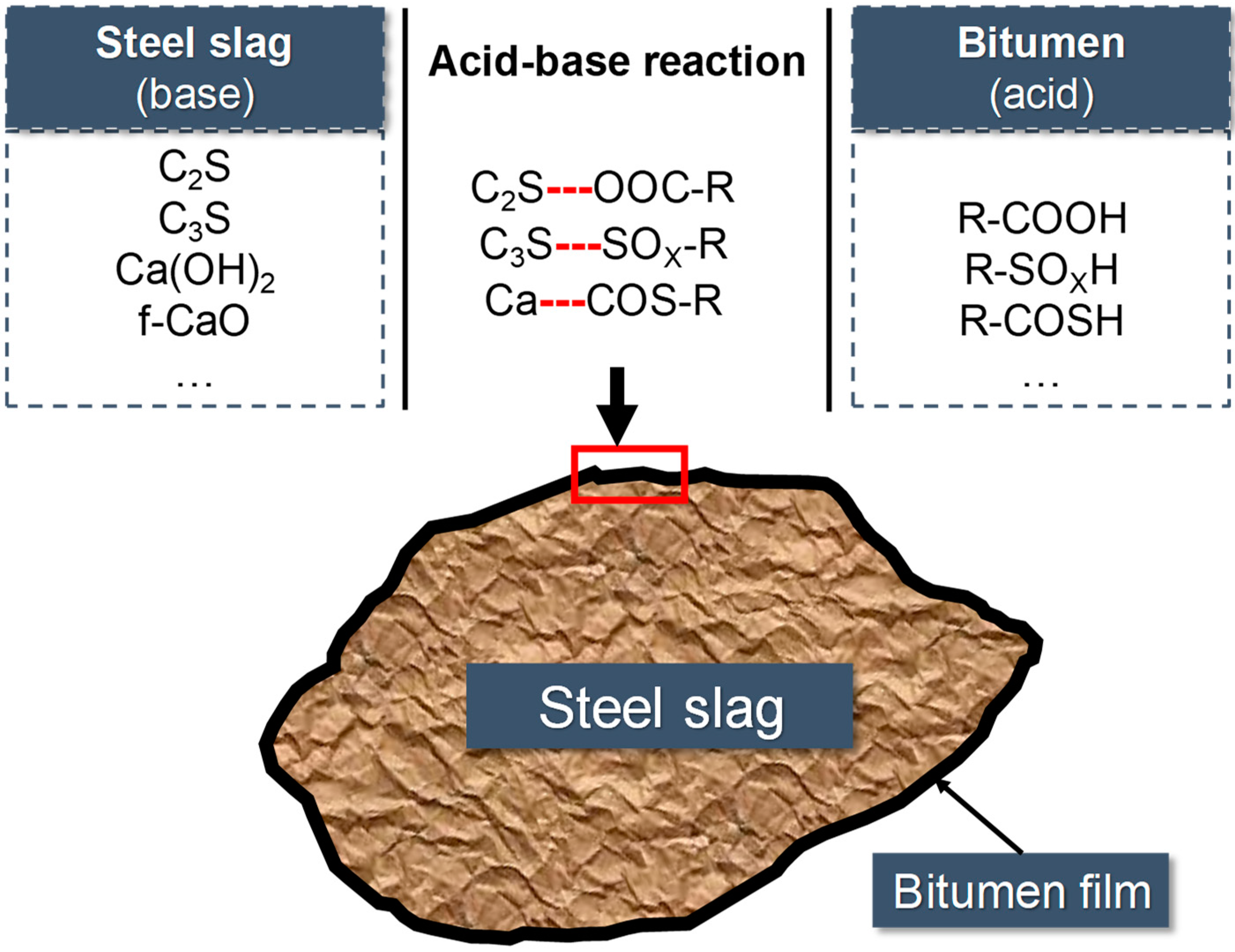
| Aggregate | Properties [21] | |||||
|---|---|---|---|---|---|---|
| Size | Water Absorption (%) | Apparent Specific Gravity | Log Angeles Abrasion (%) | Crushing Value (%) | f-CaO Content (%) | |
| RSS | 9.5–16 mm | 1.16 | 3.220 | 12.9 | 18.5 | 0.40 |
| LPSS | 9.5–16 mm | 1.44 | 3.260 | 14.5 | 13.9 | 1.17 |
| HBSS | 9.5–16 mm | 1.75 | 3.100 | 13.2 | 16.8 | 0.81 |
| Basalt [22] | 9.5–16 mm | 0.40 | 2.774 | 16.8 | 20.0 | N/A |
| Limestone [23] | 9.5–16 mm | 1.10 | 2.650 | 20.4 | N/A | N/A |
| Granite [22] | 9.5–16 mm | 0.60 | 2.723 | 21.6 | 21.9 | N/A |
| Limestone | 4.75–9.5 mm | 1.30 | 2.726 | N/A | 9.3 | N/A |
| Limestone | 2.36–4.75 mm | 1.50 | 2.822 | N/A | 9.3 | N/A |
| Requirements [24] | N/A | ≤3.00 | ≥2.500 | ≤30.0 | ≤26.0 | ≤2.00 |
| Angularity Index | ||||||
|---|---|---|---|---|---|---|
| Sample | Average Value | Standard Deviation Value | Low (≤2100) | Moderate (2100–3975) | High (3975–5400) | Extreme (5400–10,000) |
| RSS | 2946.5 | 609.6 | 0% | 95% | 5% | 0% |
| HBSS | 3292.0 | 862.2 | 5% | 75% | 15% | 5% |
| LPSS | 3725.8 | 1226.1 | 0 | 60% | 30% | 10% |
| Texture Index | ||||||
|---|---|---|---|---|---|---|
| Sample | Average Value | Standard Deviation | Low (≤200) | Moderate (200–500) | High (500–750) | Extreme (750–1000) |
| RSS | 311.4 | 81.3 | 15% | 85% | 0% | 0% |
| HBSS | 400.8 | 88.7 | 0% | 75% | 25% | 0% |
| LPSS | 477.2 | 158.4 | 5% | 60% | 25% | 10% |
| AC-13 Asphalt Mixture | RMS Test | ITS Test | ||||
|---|---|---|---|---|---|---|
| MS0 (KN) | MS1 (KN) | RMS (%) | ITS0 (MPa) | ITS1 (MPa) | TSR (%) | |
| RSS | 16.92 | 15.59 | 92.1 | 1.65 | 1.49 | 90.3 |
| HBSS | 15.82 | 14.37 | 90.8 | 1.53 | 1.35 | 88.1 |
| LPSS | 14.10 | 12.44 | 88.2 | 1.49 | 1.28 | 85.6 |
| Mixture Type | Aggregate Type | dW/dV–Strain Function | ε0 | Critical Value of dW/dV (KJ/m3) |
|---|---|---|---|---|
| AC-13 Asphalt mixture | LPSS | dW/dV = − 3 × 10 − 5ε5/5 + 0.0015ε4/4 − 0.0882ε3/3 + 1.128ε2/2 + 0.5047ε | 12.0 | 42.7 |
| HBSS | dW/dV = − 3 × 10 − 5ε5/5 + 0.0019ε4/4 − 0.0904ε3/3 + 1.39ε2/2 + 0.6116ε | 12.9 | 69.8 | |
| RSS | dW/dV = − 3 × 10 − 5ε5/5 + 0.002ε4/4 − 0.0959ε3/3 + 1.44ε2/2 + 0.8109ε | 13.3 | 73.4 |
© 2019 by the authors. Licensee MDPI, Basel, Switzerland. This article is an open access article distributed under the terms and conditions of the Creative Commons Attribution (CC BY) license (http://creativecommons.org/licenses/by/4.0/).
Share and Cite
Ye, Y.; Wu, S.; Li, C.; Kong, D.; Shu, B. Morphological Discrepancy of Various Basic Oxygen Furnace Steel Slags and Road Performance of Corresponding Asphalt Mixtures. Materials 2019, 12, 2322. https://doi.org/10.3390/ma12142322
Ye Y, Wu S, Li C, Kong D, Shu B. Morphological Discrepancy of Various Basic Oxygen Furnace Steel Slags and Road Performance of Corresponding Asphalt Mixtures. Materials. 2019; 12(14):2322. https://doi.org/10.3390/ma12142322
Chicago/Turabian StyleYe, Yong, Shaopeng Wu, Chao Li, Dezhi Kong, and Benan Shu. 2019. "Morphological Discrepancy of Various Basic Oxygen Furnace Steel Slags and Road Performance of Corresponding Asphalt Mixtures" Materials 12, no. 14: 2322. https://doi.org/10.3390/ma12142322






